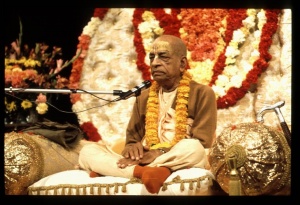SB 1.18.26: Difference between revisions
m (1 revision(s)) |
No edit summary |
||
| Line 1: | Line 1: | ||
{{info | {{info | ||
|speaker= | |speaker=Sūta Gosvāmī | ||
|listener=Sages of | |listener=Sages of Naimiṣāraṇya | ||
}} | }} | ||
[[Category:Srimad-Bhagavatam - Canto 01 Chapter 18]] | |||
[[Category:Bhagavatam Verses Spoken by Suta Gosvami - Vanisource|011826]] | |||
<div style="float:left">'''[[Srimad-Bhagavatam]] - [[SB 1|First Canto]] - [[SB 1.18: Maharaja Pariksit Cursed by a Brahmana Boy|Chapter 18: Mahārāja Parīkṣit Cursed by a Brāhmaṇa Boy]]'''</div> | |||
<div style="float:right">[[File:Go-previous.png|link=SB 1.18.24-25]] '''[[SB 1.18.24-25]] - [[SB 1.18.27]]''' [[File:Go-next.png|link=SB 1.18.27]]</div> | |||
{{CompareVersions|SB|1.18.26|SB 1965|SB 1972-77}} | |||
{{RandomImage}} | |||
==== TEXT 26 ==== | ==== TEXT 26 ==== | ||
<div class="verse"> | |||
<div | :pratiruddhendriya-prāṇa- | ||
pratiruddhendriya-prāṇa- | :mano-buddhim upāratam | ||
mano-buddhim upāratam | :sthāna-trayāt paraṁ prāptaṁ | ||
sthāna-trayāt paraṁ prāptaṁ | :brahma-bhūtam avikriyam | ||
brahma-bhūtam avikriyam | |||
</div> | </div> | ||
| Line 18: | Line 23: | ||
==== SYNONYMS ==== | ==== SYNONYMS ==== | ||
<div class="synonyms"> | |||
<div | ''pratiruddha''—restrained; ''indriya''—the sense organs; ''prāṇa''—air of respiration; ''manaḥ''—the mind; ''buddhim''—intelligence; ''upāratam''—inactive; ''sthāna''—places; ''trayāt''—from the three; ''param''—transcendental; ''prāptam''—achieved; ''brahma-bhūtam''—qualitatively equal with the Supreme Absolute; ''avikriyam''—unaffected. | ||
</div> | </div> | ||
| Line 26: | Line 30: | ||
==== TRANSLATION ==== | ==== TRANSLATION ==== | ||
<div class="translation"> | |||
<div | |||
The muni's sense organs, breath, mind and intelligence were all restrained from material activities, and he was situated in a trance apart from the three [wakefulness, dream and unconsciousness], having achieved a transcendental position qualitatively equal with the Supreme Absolute. | The muni's sense organs, breath, mind and intelligence were all restrained from material activities, and he was situated in a trance apart from the three [wakefulness, dream and unconsciousness], having achieved a transcendental position qualitatively equal with the Supreme Absolute. | ||
</div> | </div> | ||
| Line 34: | Line 37: | ||
==== PURPORT ==== | ==== PURPORT ==== | ||
<div class="purport"> | |||
It appears that the ''muni'', in whose hermitage the King entered, was in yogic trance. The transcendental position is attained by three processes, namely the process of ''jñāna'', or theoretical knowledge of transcendence, the process of ''yoga'', or factual realization of trance by manipulation of the physiological and psychological functions of the body, and the most approved process of ''bhakti-yoga'', or the engagement of senses in the devotional service of the Lord. In the [[Bhagavad-gita As It Is (1972)|''Bhagavad-gītā'']] also we have the information of the gradual development of perception from matter to a living entity. Our material mind and body develop from the living entity, the soul, and being influenced by the three qualities of matter, we forget our real identity. The ''jñāna'' process theoretically speculates about the reality of the soul. But ''bhakti-yoga'' factually engages the spirit soul in activities. The perception of matter is transcended to still subtler states of the senses. The senses are transcended to the subtler mind, and then to breathing activities and gradually to intelligence. Beyond the intelligence, the living soul is realized by the mechanical activities of the ''yoga'' system, or practice of meditation restraining the senses, regulating the breathing system and applying intelligence to rise to the transcendental position. This trance stops all material activities of the body. The King saw the ''muni'' in that position. He also saw the ''muni'' as follows. | |||
</div> | |||
<div | |||
<div style="float:right; clear:both;">[[File:Go-previous.png|link=SB 1.18.24-25]] '''[[SB 1.18.24-25]] - [[SB 1.18.27]]''' [[File:Go-next.png|link=SB 1.18.27]]</div> | |||
</div> | __NOTOC__ | ||
__NOTOC__ | __NOEDITSECTION__ | ||
Revision as of 02:35, 3 May 2021

A.C. Bhaktivedanta Swami Prabhupada
TEXT 26
- pratiruddhendriya-prāṇa-
- mano-buddhim upāratam
- sthāna-trayāt paraṁ prāptaṁ
- brahma-bhūtam avikriyam
SYNONYMS
pratiruddha—restrained; indriya—the sense organs; prāṇa—air of respiration; manaḥ—the mind; buddhim—intelligence; upāratam—inactive; sthāna—places; trayāt—from the three; param—transcendental; prāptam—achieved; brahma-bhūtam—qualitatively equal with the Supreme Absolute; avikriyam—unaffected.
TRANSLATION
The muni's sense organs, breath, mind and intelligence were all restrained from material activities, and he was situated in a trance apart from the three [wakefulness, dream and unconsciousness], having achieved a transcendental position qualitatively equal with the Supreme Absolute.
PURPORT
It appears that the muni, in whose hermitage the King entered, was in yogic trance. The transcendental position is attained by three processes, namely the process of jñāna, or theoretical knowledge of transcendence, the process of yoga, or factual realization of trance by manipulation of the physiological and psychological functions of the body, and the most approved process of bhakti-yoga, or the engagement of senses in the devotional service of the Lord. In the Bhagavad-gītā also we have the information of the gradual development of perception from matter to a living entity. Our material mind and body develop from the living entity, the soul, and being influenced by the three qualities of matter, we forget our real identity. The jñāna process theoretically speculates about the reality of the soul. But bhakti-yoga factually engages the spirit soul in activities. The perception of matter is transcended to still subtler states of the senses. The senses are transcended to the subtler mind, and then to breathing activities and gradually to intelligence. Beyond the intelligence, the living soul is realized by the mechanical activities of the yoga system, or practice of meditation restraining the senses, regulating the breathing system and applying intelligence to rise to the transcendental position. This trance stops all material activities of the body. The King saw the muni in that position. He also saw the muni as follows.